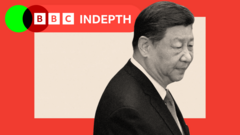Looking at a vast but cautious domestic market, the Chinese populace is increasingly hesitant to spend, an issue driven by a crashing housing market and fears regarding future job security amidst an aging demographic. Instead of the anticipated economic boom, consumers are holding back, especially after witnessing substantial losses on real estate investments. Former officials have highlighted that excess housing inventory could fill many more than just the national population, resulting in a glutted market full of "ghost cities."
This economic climate is further compounded by a youth unemployment rate above 20%, leaving younger generations disillusioned about their prospects and financial stability, which threatens political unrest. In the face of mounting dissatisfaction, Xi must reconcile his 2012 promise of national prosperity with the reality on the ground, as dissatisfaction rises among a younger and increasingly vocal demographic.
As the government rolls out measures to invigorate spending with incentives like childcare subsidies and discounts on consumer goods, experts caution that such plans lack sustainability without significant increases in disposable income. The challenge lies not just in generating short-term consumer spending but in establishing a robust long-term framework for economic growth and stability.
Furthermore, despite Xi’s efforts to pivot China towards technological advancements in areas like electric vehicles and AI, U.S. restrictions on key exports present significant roadblocks in achieving this goal. However, Xi is leveraging the current crisis as an opportunity, expanding trade ties with alternative markets across Southeast Asia, Africa, and Latin America to mitigate the economic fallout from U.S. tariffs.
In stark contrast to their previous reliance on American markets, over 145 countries now engage in more trade with China than the United States, revealing a notable shift in global trade dynamics. Nonetheless, as Xi pursues these new relationships, he must navigate existing geopolitical tensions and ensure that increased production does not inadvertently harm local economies in these regions.
Amidst these challenges and in the face of Trump’s changing rhetoric on tariffs, Xi appears to be focused on long-term strategies rather than immediate fixes, with the hope that China can outlast the pressures exerted by both tariffs and demographic shifts. Ultimately, while trade relations remain fraught with uncertainties, the internal reforms China undertakes may very well define Xi’s legacy and the country's future in global economics.
This economic climate is further compounded by a youth unemployment rate above 20%, leaving younger generations disillusioned about their prospects and financial stability, which threatens political unrest. In the face of mounting dissatisfaction, Xi must reconcile his 2012 promise of national prosperity with the reality on the ground, as dissatisfaction rises among a younger and increasingly vocal demographic.
As the government rolls out measures to invigorate spending with incentives like childcare subsidies and discounts on consumer goods, experts caution that such plans lack sustainability without significant increases in disposable income. The challenge lies not just in generating short-term consumer spending but in establishing a robust long-term framework for economic growth and stability.
Furthermore, despite Xi’s efforts to pivot China towards technological advancements in areas like electric vehicles and AI, U.S. restrictions on key exports present significant roadblocks in achieving this goal. However, Xi is leveraging the current crisis as an opportunity, expanding trade ties with alternative markets across Southeast Asia, Africa, and Latin America to mitigate the economic fallout from U.S. tariffs.
In stark contrast to their previous reliance on American markets, over 145 countries now engage in more trade with China than the United States, revealing a notable shift in global trade dynamics. Nonetheless, as Xi pursues these new relationships, he must navigate existing geopolitical tensions and ensure that increased production does not inadvertently harm local economies in these regions.
Amidst these challenges and in the face of Trump’s changing rhetoric on tariffs, Xi appears to be focused on long-term strategies rather than immediate fixes, with the hope that China can outlast the pressures exerted by both tariffs and demographic shifts. Ultimately, while trade relations remain fraught with uncertainties, the internal reforms China undertakes may very well define Xi’s legacy and the country's future in global economics.




















